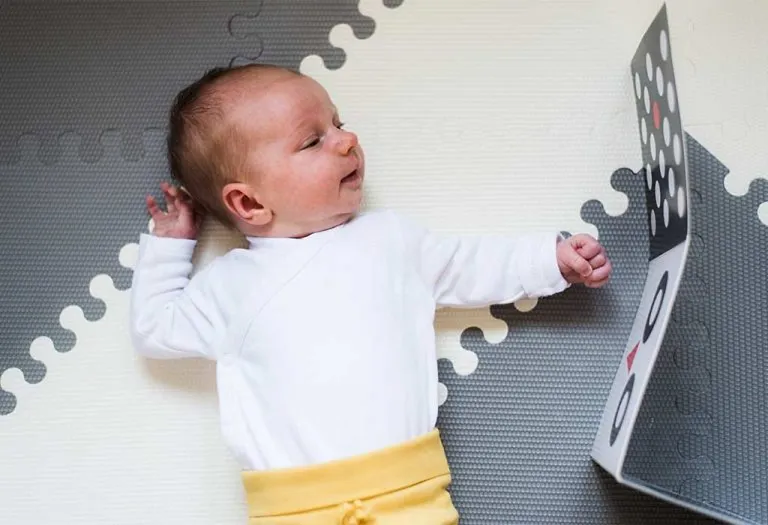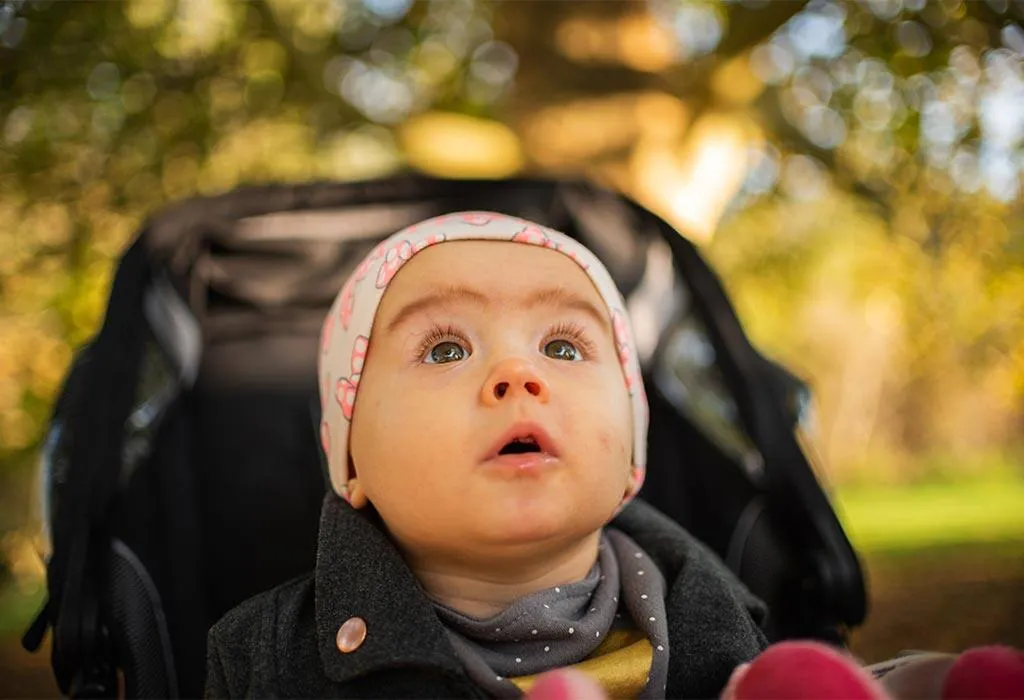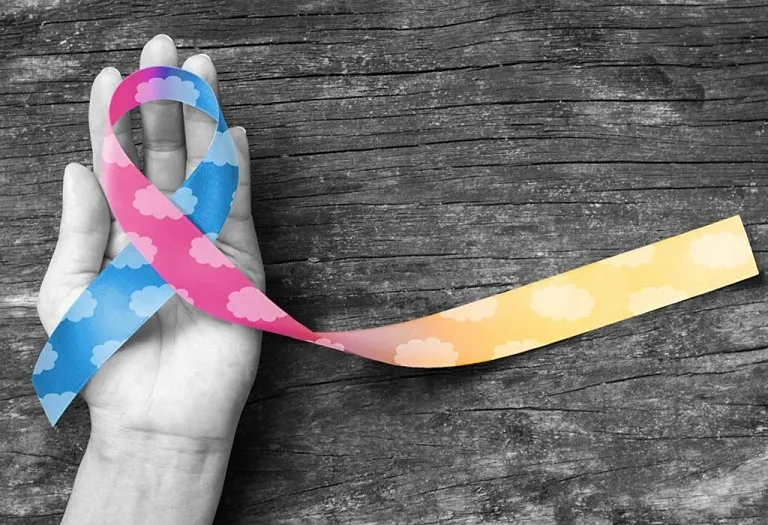When Can Babies See Colour – Stages Of Colour Vision Development
One of the most heartwarming moments for a parent is witnessing their baby’s first reactions to the vibrant world around them. As their little eyes take in the surrounding beauty, a common query arises: “What colours can babies see at 1, 2, and 3rd months?” Let’s journey to understand babies’ fascinating stages of colour vision development.
When Are Babies Able To See Colour?
It is a remarkable moment when a baby gazes into a parent’s eyes, seemingly perceiving the world’s hues. But when do babies start seeing colour? This question often pops up in new parents’ minds. If you’re wondering, “At what age can babies see colour?” and eager to understand how their little one’s vision develops, let’s dive deeper into the fascinating journey of a baby’s evolving perception of colour.
Babies primarily discern contrasts early after birth, especially between black and white. It’s akin to looking through a misty lens, where they sense changes in light but not vibrant colours. But their eyes expand as days become weeks and weeks into months (1).
Around the 2 to 3-month mark, red becomes more distinguishable (2). This is because the red cones—the colour receptors in our eyes—start maturing faster than the other cones. Thus, red toys or patterns might captivate a baby’s attention more during this period.
By the end of the third month, blues and yellows enter their visual spectrum. Intriguingly, green often takes a little longer, with many babies beginning to recognise it closer to the 4 to 5-month mark (3).
However, by half a year or around six months, most babies have a nearly full spectrum of colour vision (3). This period is an exciting time of discovery, as babies show a distinct preference or fascination with specific colours. They often gaze intently at colourful objects or respond with glee to vibrant surroundings.
Every baby is unique, and while these are general guidelines, it’s crucial to remember that individual milestones may vary. Whether a baby is taking in the world in shades or full colour, every stage of its development is a wonder. As parents and caregivers, we can help foster a baby’s growth and development by revelling in each stage, understanding it, and providing a stimulating environment.
What Colours Can Baby See First?
As newborns visually explore the world, many parents wonder, “Can babies see colour from the get-go?” Initially, babies are more attuned to contrasts, making black, white, and shades of grey the most distinguishable. These high-contrast colours captivate their attention, paving the way for the gradual unveiling of a more vibrant and colourful world in the subsequent months.
How Does The Colour Vision Develop In Babies?
As tiny tots grow, their perception of the world continually evolves. One intriguing aspect of this development is the progression of their colour vision. From blurry shades to a vivid spectrum, let’s trace the journey of colour perception during a baby’s first year.
Birth To 3 Months
- Newborns primarily perceive contrasts, making black, white, and shades of grey the most apparent colours.
- Around the 2-month mark, the colour red starts becoming discernible, thanks to the maturing of the red cones in their eyes.
- Blues and yellows begin to emerge towards the end of this period, although not as distinctively as red.
- The overall visual acuity remains limited; everything they see is still blurry.
- Their focus is generally on objects 8 to 12 inches away from them, often locking onto parents’ faces.
- It’s common for babies to be drawn to high-contrast patterns and shapes during these initial months (4).
Four To Six Months
- The colour differentiation ability strengthens during this phase, making green more distinguishable.
- Their visual clarity also sharpens, allowing them to perceive finer details in objects.
- Recognition of primary colours becomes more apparent, and babies may begin to show preferences.
- Depth perception starts to develop, allowing them to judge distances better.
- Their hand-eye coordination improves, enabling them to reach out for colourful toys or objects that attract their attention.
- By the end of six months, most babies’ colour vision closely resembles that of adults (4).
Seven To Nine Months
- With a nearly full spectrum of colour vision established, babies now begin to recognise even subtle colour variations.
- Their ability to track moving objects improves significantly, mainly when they follow colourful toys or people moving around.
- At this stage, babies might develop favourite colours and show an apparent inclination towards certain toys or objects based on their hue.
- They become more interactive with their environment, and colourful objects can play a role in stimulating cognitive development (4).
Ten To Twelve Months
- By now, babies perceive colours and begin associating them with objects, like recognising the yellow of a banana or the green of leaves.
- Their memory retention improves, allowing them to remember and recognise their favourite colourful toys or objects.
- Colour-based games, such as basic colour sorting or naming, can become engaging activities that lay the foundation for early learning (4).
Benefits Of Colour Vision for Babies
Colours are more than just a feast for the eyes; they play an integral role in a child’s cognitive and emotional development. As babies’ colour vision matures, it enriches their visual experiences and influences their growth and understanding of the world. Let’s delve into the myriad benefits of colour vision for these young explorers.
1. Stimulates Cognitive Development: Recognising and distinguishing between colours can boost a baby’s memory and attention span. Their cognitive skills also improve as they learn to associate colours with objects.
2. Enhances Mood and Emotion: Colours can influence emotions and moods. Bright colours might make babies feel cheerful and stimulated, while softer colours might be calming.
3. Boosts Creativity: As babies recognise colours, they can be more expressive during activities like finger painting or scribbling, laying the foundation for creativity.
4. Improves Communication Skills: Even before babies can speak, they might express preferences or dislikes based on colour. This non-verbal communication can be a precursor to them using words to describe what they see and feel (5).
5. Aids in Safety: As their colour vision develops, babies learn to recognise colours that signify caution (like red) or safety (like green), aiding in their understanding of their environment.
6. Enhances Learning: Educational toys often use colours to teach babies about shapes, numbers, and the alphabet. Thus, recognition of colours can be a stepping stone to early learning.
What Are The Early Signs Of Colour Blindness In Babies?
Colour blindness, or the inability to perceive specific colours or differences between colours, is a genetic condition many parents question, “Are babies colour blind?” is a commonly asked question. While all babies develop their colour vision gradually, it’s essential to recognise early signs of colourblindness to ensure proper understanding and care. Here are some indicators to look out for (4):
- Inconsistent Responses to Colours: If a baby reacts to specific colours one day but seems indifferent to them the next, it could be an indication.
- Difficulty with Colour-Based Tasks: As they grow, if babies consistently struggle with or show disinterest in activities that require colour recognition, it might be a sign.
- Frequent Mistaking of One Colour for Another: Confusing colours, especially reds and greens or blues and yellows, can be a telltale sign.
- Lack of Interest in Brightly Coloured Toys: Babies typically get attracted to vibrant hues. If a child seems uninterested, it could be because they don’t perceive these colours as most do.
- Trouble Identifying Shades: Children with colour blindness might find it challenging to differentiate between shades of the same colour.
- Overly Sensitive Eyes: Some kids with colour blindness might squint or seem overly sensitive to bright lights.
- Difficulty with Pattern Recognition: Patterns that use contrasting colours might appear different to them, making them challenging to recognise.
- Late Development of Colour Naming: If, as toddlers, they lag in naming or recognising colours compared to their peers, it might be a sign.
- Family History: Colour blindness is often hereditary. If there’s a family history, especially on the mother’s side, there’s a higher likelihood of the child inheriting the condition.
Other Warning Signs Of Baby’s Vision Development
During the first year, a baby’s vision undergoes rapid changes. While many of these transformations are part of the natural developmental process, some signs might indicate potential vision issues that warrant attention. Recognising these early warning signs is crucial to promptly addressing concerns and providing the necessary care (4).
- Excessive Tearing: While it’s natural for babies to produce tears, an overproduction could suggest blocked tear ducts or other vision issues.
- Persistent Eye Redness: Occasional redness is typical, but persistent redness might indicate an infection or another underlying condition.
- Extreme Light Sensitivity: If a baby seems overly sensitive to indoor lights or sunlight more than usual, it could be a cause for concern.
- Constant Eye Rubbing: While occasional rubbing might just indicate tiredness, constantly rubbing their eyes might indicate a vision problem.
- Poor Tracking: By three months, most babies can follow a moving object with their eyes. It could be a sign of an issue if they struggle with tracking.
- Crossed Eyes or Strabismus: Occasionally, crossed eyes can be expected in newborns, but if they persist beyond four months, they might indicate a vision development problem.
- White Pupil: If you notice a white or greyish-white colour in the pupil of a baby’s retina under lights or photographs, it can be an early sign of some severe conditions, such as retinoblastoma.
- Lack of Interest in Faces or Surroundings: Babies naturally gravitate towards human faces. If they seem disinterested or don’t see faces for three months, this might indicate a vision concern.
- Difference in Eye Appearance: If one eye appears larger, has a droopy lid, or has any other noticeable difference, it could indicate an underlying issue.
How To Develop Colour Vision In Babies?
Nurturing a baby’s vision is a blend of guidance and gentle nudges from their environment. While the development of colour vision primarily follows a natural trajectory, parents can play an active role in stimulating and enriching this process. Engaging babies with colourful toys, exposing them to varied environments, and interacting through colour-rich games can help them recognise and appreciate the myriad hues of their blossoming world. Encouraging visual exploration not only supports their colour vision but also fosters overall cognitive and sensory development.
When To Consult a Doctor?
While every baby’s visual journey baby is unique, certain signs might warrant a closer look from a professional. If parents notice unusual eye movements, persistent issues like constant eye redness or tearing, or any delay in developmental milestones related to vision, it’s crucial to consult a pediatric ophthalmologist. An early diagnosis can pave the way for timely interventions, ensuring your little one’s visual world remains as vibrant and straightforward as possible.
FAQs
1. Why do babies see red as their first colour?
Babies see red as their first colour primarily because the red cones in their eyes mature. During the first months after birth, these red cones develop faster than those responsible for blue and green. As a result, red becomes one of the first colours babies can distinguish amidst the initially dominant black, white, and grey tones.
2. Do babies attract to bright colours?
Yes, babies are naturally attracted to bright colours. Bright colours’ high contrast and vividness stimulate their developing visual system, making these hues more noticeable and engaging. This attraction captivates their attention and plays a significant role in their cognitive and sensory development.
Every milestone in a baby’s vision development, from discerning contrasts to recognising a full spectrum of colours, is a testament to the wonders of human growth. As parents and caregivers, understanding this progression and being attuned to a baby’s visual needs ensures a vibrant and enriching start to their exploration of the world.
References/Resources:
1. Infant Vision Birth to One Year; Nationwide Children’s Organisation; https://www.nationwidechildrens.org/family-resources-education/health-wellness-and-safety-resources/helping-hands/infant-vision-birth-to-one-year
2. The Newborn Senses: Sight and Eye Color; Charlotte Lozier Institute; https://lozierinstitute.org/dive-deeper/the-newborn-senses-sight-and-eye-color/
3. Infant Vision Development: What Can Babies See?; Healthy Children; https://www.healthychildren.org/English/ages-stages/baby/Pages/Babys-Vision-Development.aspx
Also Read:
Ideas for Visual Stimulation in Infants
When Do Newborns Make Eye Contact
Was This Article Helpful?
Parenting is a huge responsibility, for you as a caregiver, but also for us as a parenting content platform. We understand that and take our responsibility of creating credible content seriously. FirstCry Parenting articles are written and published only after extensive research using factually sound references to deliver quality content that is accurate, validated by experts, and completely reliable. To understand how we go about creating content that is credible, read our editorial policy here.























